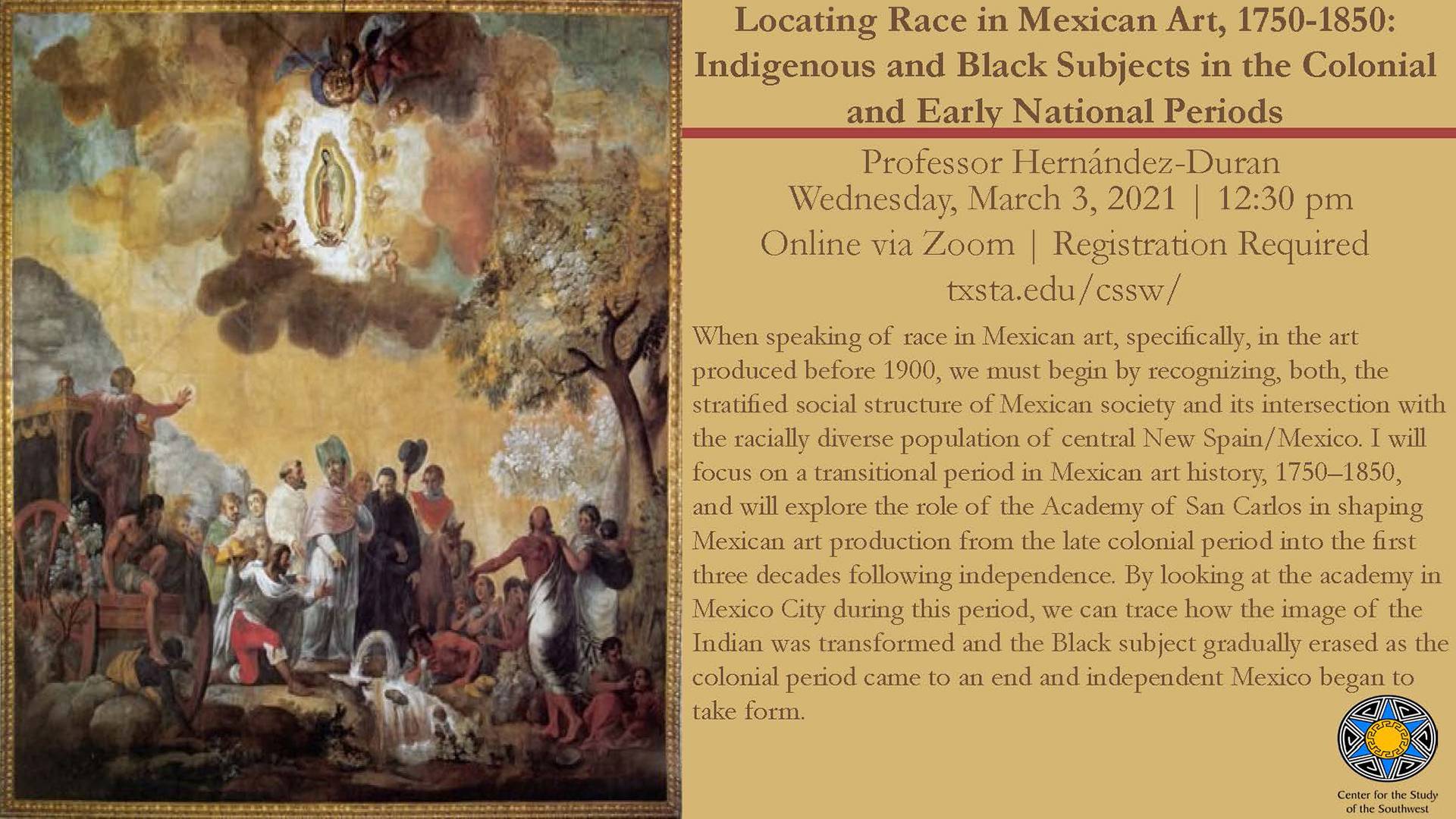When speaking of race in Mexican art, specifically, in the art produced before 1900, we must begin by recognizing, both, the stratified social structure of Mexican society and its intersection with the racially diverse population of central New Spain/Mexico. If considering the relationship between race and art production in Mexico City, a leading question then becomes: are we looking at the art produced BY Indigenous and Black artists OR are we examining the representation OF these racialized subjects IN art? These are two very important yet different questions that communicate distinct things about the role of artists and patrons in art production, the kinds of art forms produced and the subjects depicted, and the circulation and reception of art. In this talk, I will focus on a transitional period in Mexican art history, 1750–1850, and will explore the role of the Academy of San Carlos in shaping Mexican art production from the late colonial period into the first three decades following independence. By looking at the academy in Mexico City during this period, we can trace how the image of the Indian was transformed and the Black subject gradually erased as the colonial period came to an end and independent Mexico began to take form.
 Ray Hernández-Durán, originally from San Antonio, Texas, completed his M.A. in Art of Africa and the African Diaspora at the University of Wisconsin-Madison and his Ph.D. in Pre-Hispanic and Colonial Latin American Art History at the University of Chicago. He is currently a Professor of Spanish Colonial Art History in the Department of Art at the University of New Mexico in Albuquerque. Outside of his colonial art classes, he teaches, Arts of 19th Century Mexico, Baroque Art and Architecture, Arts of Spain, U.S. Latinx Art, African Art, and Museum Studies. His research specializations are grounded, geographically, in New Spain/Mexico/U.S. Southwest and historically, in the 18th- and 19th centuries. His book, The Academy of San Carlos and Mexican Art History: Politics, History, and Art in Nineteenth-Century Mexico (Routledge, 2017) will be followed by two publications, A Historiography of Colonial Art in Mexico, ca. 1855–1934 (University of New Mexico Press, forthcoming 2022) and A Routledge Companion to U.S. Latinx Art, for which he was invited to serve as editor (forthcoming 2023). Ray has been the recipient of various awards throughout his academic career, among them, a Fulbright-Hays Research Fellowship to Nigeria, a Fulbright-Hays Dissertation Fellowship to Mexico, an Iberian Studies Research Fellowship to Haiti, a Title V.I. F.L.A.S. Award for the study of Portuguese in Brazil, a Title V.I. F.L.A.S. Award for the study of Yoruba, an NEH Grant, and an Andy Warhol Foundation Grant. He has given papers at a variety of conferences and symposia, and presented his work at universities, museums, and institutes throughout the U.S. and abroad, including, the Smithsonian Art Institution in Washington, D.C.; the Courtauld Art Institute in London; the Clark Institute in Williamstown, Massachusetts; Universidad San Francisco de Quito in Ecuador; and the Instituto de Investigaciones Estéticas at the UNAM in Mexico City, among others. He is currently co-curating an exhibition of Chicano and Chicana artists who were part of the early movimiento in New Mexico from 1970 to 1980 and developing an article on Tejano artist, Vincent Valdes’s great grandfather, who was a painter working in San Antonio, Texas in the 1930s and 1940s.
Ray Hernández-Durán, originally from San Antonio, Texas, completed his M.A. in Art of Africa and the African Diaspora at the University of Wisconsin-Madison and his Ph.D. in Pre-Hispanic and Colonial Latin American Art History at the University of Chicago. He is currently a Professor of Spanish Colonial Art History in the Department of Art at the University of New Mexico in Albuquerque. Outside of his colonial art classes, he teaches, Arts of 19th Century Mexico, Baroque Art and Architecture, Arts of Spain, U.S. Latinx Art, African Art, and Museum Studies. His research specializations are grounded, geographically, in New Spain/Mexico/U.S. Southwest and historically, in the 18th- and 19th centuries. His book, The Academy of San Carlos and Mexican Art History: Politics, History, and Art in Nineteenth-Century Mexico (Routledge, 2017) will be followed by two publications, A Historiography of Colonial Art in Mexico, ca. 1855–1934 (University of New Mexico Press, forthcoming 2022) and A Routledge Companion to U.S. Latinx Art, for which he was invited to serve as editor (forthcoming 2023). Ray has been the recipient of various awards throughout his academic career, among them, a Fulbright-Hays Research Fellowship to Nigeria, a Fulbright-Hays Dissertation Fellowship to Mexico, an Iberian Studies Research Fellowship to Haiti, a Title V.I. F.L.A.S. Award for the study of Portuguese in Brazil, a Title V.I. F.L.A.S. Award for the study of Yoruba, an NEH Grant, and an Andy Warhol Foundation Grant. He has given papers at a variety of conferences and symposia, and presented his work at universities, museums, and institutes throughout the U.S. and abroad, including, the Smithsonian Art Institution in Washington, D.C.; the Courtauld Art Institute in London; the Clark Institute in Williamstown, Massachusetts; Universidad San Francisco de Quito in Ecuador; and the Instituto de Investigaciones Estéticas at the UNAM in Mexico City, among others. He is currently co-curating an exhibition of Chicano and Chicana artists who were part of the early movimiento in New Mexico from 1970 to 1980 and developing an article on Tejano artist, Vincent Valdes’s great grandfather, who was a painter working in San Antonio, Texas in the 1930s and 1940s.


 Ray Hernández-Durán, originally from San Antonio, Texas, completed his M.A. in Art of Africa and the African Diaspora at the University of Wisconsin-Madison and his Ph.D. in Pre-Hispanic and Colonial Latin American Art History at the University of Chicago. He is currently a Professor of Spanish Colonial Art History in the Department of Art at the University of New Mexico in Albuquerque. Outside of his colonial art classes, he teaches, Arts of 19th Century Mexico, Baroque Art and Architecture, Arts of Spain, U.S. Latinx Art, African Art, and Museum Studies. His research specializations are grounded, geographically, in New Spain/Mexico/U.S. Southwest and historically, in the 18th- and 19th centuries. His book, The Academy of San Carlos and Mexican Art History: Politics, History, and Art in Nineteenth-Century Mexico (Routledge, 2017) will be followed by two publications, A Historiography of Colonial Art in Mexico, ca. 1855–1934 (University of New Mexico Press, forthcoming 2022) and A Routledge Companion to U.S. Latinx Art, for which he was invited to serve as editor (forthcoming 2023). Ray has been the recipient of various awards throughout his academic career, among them, a Fulbright-Hays Research Fellowship to Nigeria, a Fulbright-Hays Dissertation Fellowship to Mexico, an Iberian Studies Research Fellowship to Haiti, a Title V.I. F.L.A.S. Award for the study of Portuguese in Brazil, a Title V.I. F.L.A.S. Award for the study of Yoruba, an NEH Grant, and an Andy Warhol Foundation Grant. He has given papers at a variety of conferences and symposia, and presented his work at universities, museums, and institutes throughout the U.S. and abroad, including, the Smithsonian Art Institution in Washington, D.C.; the Courtauld Art Institute in London; the Clark Institute in Williamstown, Massachusetts; Universidad San Francisco de Quito in Ecuador; and the Instituto de Investigaciones Estéticas at the UNAM in Mexico City, among others. He is currently co-curating an exhibition of Chicano and Chicana artists who were part of the early movimiento in New Mexico from 1970 to 1980 and developing an article on Tejano artist, Vincent Valdes’s great grandfather, who was a painter working in San Antonio, Texas in the 1930s and 1940s.
Ray Hernández-Durán, originally from San Antonio, Texas, completed his M.A. in Art of Africa and the African Diaspora at the University of Wisconsin-Madison and his Ph.D. in Pre-Hispanic and Colonial Latin American Art History at the University of Chicago. He is currently a Professor of Spanish Colonial Art History in the Department of Art at the University of New Mexico in Albuquerque. Outside of his colonial art classes, he teaches, Arts of 19th Century Mexico, Baroque Art and Architecture, Arts of Spain, U.S. Latinx Art, African Art, and Museum Studies. His research specializations are grounded, geographically, in New Spain/Mexico/U.S. Southwest and historically, in the 18th- and 19th centuries. His book, The Academy of San Carlos and Mexican Art History: Politics, History, and Art in Nineteenth-Century Mexico (Routledge, 2017) will be followed by two publications, A Historiography of Colonial Art in Mexico, ca. 1855–1934 (University of New Mexico Press, forthcoming 2022) and A Routledge Companion to U.S. Latinx Art, for which he was invited to serve as editor (forthcoming 2023). Ray has been the recipient of various awards throughout his academic career, among them, a Fulbright-Hays Research Fellowship to Nigeria, a Fulbright-Hays Dissertation Fellowship to Mexico, an Iberian Studies Research Fellowship to Haiti, a Title V.I. F.L.A.S. Award for the study of Portuguese in Brazil, a Title V.I. F.L.A.S. Award for the study of Yoruba, an NEH Grant, and an Andy Warhol Foundation Grant. He has given papers at a variety of conferences and symposia, and presented his work at universities, museums, and institutes throughout the U.S. and abroad, including, the Smithsonian Art Institution in Washington, D.C.; the Courtauld Art Institute in London; the Clark Institute in Williamstown, Massachusetts; Universidad San Francisco de Quito in Ecuador; and the Instituto de Investigaciones Estéticas at the UNAM in Mexico City, among others. He is currently co-curating an exhibition of Chicano and Chicana artists who were part of the early movimiento in New Mexico from 1970 to 1980 and developing an article on Tejano artist, Vincent Valdes’s great grandfather, who was a painter working in San Antonio, Texas in the 1930s and 1940s.